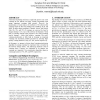Free Online Productivity Tools
i2Speak
i2Symbol
i2OCR
iTex2Img
iWeb2Print
iWeb2Shot
i2Type
iPdf2Split
iPdf2Merge
i2Bopomofo
i2Arabic
i2Style
i2Image
i2PDF
iLatex2Rtf
Sci2ools
SIGSOFT
2007
ACM
2007
ACM
Which warnings should I fix first?
Automatic bug-finding tools have a high false positive rate: most warnings do not indicate real bugs. Usually bug-finding tools assign important warnings high priority. However, the prioritization of tools tends to be ineffective. We observed the warnings output by three bug-finding tools, FindBugs, JLint, and PMD, for three subject programs, Columba, Lucene, and Scarab. Only 6%, 9%, and 9% of warnings are removed by bug fix changes during 1 to 4 years of the software development. About 90% of warnings remain in the program or are removed during non-fix changes ? likely false positive warnings. The tools' warning prioritization is little help in focusing on important warnings: the maximum possible precision by selecting highpriority warning instances is only 3%, 12%, and 8% respectively. In this paper, we propose a history-based warning prioritization algorithm by mining warning fix experience that is recorded in the software change history. The underlying intuition is that if wa...
False Positive Warnings | Important Warnings | SIGSOFT 2007 | Software Engineering | Warning Prioritization Algorithm |
| Added | 20 Nov 2009 |
| Updated | 20 Nov 2009 |
| Type | Conference |
| Year | 2007 |
| Where | SIGSOFT |
| Authors | Sunghun Kim, Michael D. Ernst |
Comments (0)

